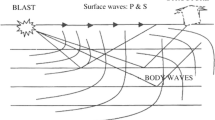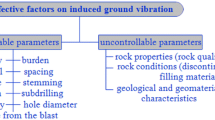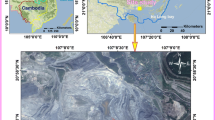Abstract
Air overpressure (AOp) and peak particle velocity (PPV) are the most undesirable effects of blasting in mines. It is an urgent need to design a predictor model for AOp and PPV for universal applications to minimize environmental effects and damages that occur due to blasting. The present study attempts to design an artificial neural network (ANN) model for the prediction of AOp and PPV in different conditions. In this study, the blast design parameters (number of holes, depth of the blast hole, stemming length, spacing, burden, distance of vibration monitoring location from the blast site, charge weight per delay) of two active mines (coal and iron ore) are considered in four different conditions for training and testing of the model for the prediction of AOp and PPV. The model was trained and tested in four different combinations of data (trained using data of one mine and tested using data of another mine, trained and tested using data of coal mine, trained and tested using data of an iron ore mine, trained and tested using combined data of both the mines) for examining the applicability in different conditions. The results indicate that R2 values are ranged from 0.886 to 0.908 and 0.8728 to 0.8959, respectively, in the prediction of PPV and AOp. A comparative study of the performances of the developed model with the other empirical model is also demonstrated. For this, the site constants of different empirical models were estimated individually for both the mines. The study results indicated that the ANN model performs much better than all the empirical models. It can be inferred from the results that blast vibration cannot be accurately predicted only from charge per delay and distance from the blast hole. The ANN model was considered many other factors and thus can predict the vibration level more accurately.








Similar content being viewed by others
References
Ambraseys NR, Hendron AJ (1968) Dynamic behaviour of rock masses. In: Stagg KG, Zienkiewicz OC (eds) Rock mechanics in engineering practice. Wiley, London, pp 203–227
Amiri M, Bakhshandeh AH, Hasanipanah M, Mohammad KL (2016) A new combination of artificial neural network and K-nearest neighbors models to predict blast-induced ground vibration and air-overpressure. Eng Comput 32:631–644. https://doi.org/10.1007/s00366-016-0442-5
Armaghani DJ, Hasanipanah M, Amnieh HB, Mohamad ET (2018) Feasibility of ICA in approximating ground vibration resulting from mine blasting. Neural Comput Applic 29(9):457–465
Athanasopoulos GA, Pelekis PC (2000) Ground vibrations from sheetpile driving in urban environment: measurements, analysis and effects on buildings and occupants. Soil Dyn Earthq Eng 19:371–387. https://doi.org/10.1016/S0267-7261(00)00008-7
BIS 6922 (1973) Criteria for safety and design of structures subject to underground blast. Bureau of Indian Standards, New Delhi, India. Available at: https://civilplanets.com/wp-content/uploads/2020/04/6922.pdf
Blair DP (2014) Blast vibration dependence on charge length, velocity of detonation and layered media. Int J Rock Mech Min Sci 65:29–39. https://doi.org/10.1016/j.ijrmms.2013.11.007
Bui XN, Nguyen H, Le HA, Bui HB, Do NH (2020) Prediction of blast-induced air over-pressure in open-pit mine: assessment of different artificial intelligence techniques. Nat Resour Res 29:571–591. https://doi.org/10.1007/s11053-019-09461-0
Dauetas AA, Denisyuk II, Kuzmenko AA, Vorobev VD (1993) Seismic effects of blasting in rock. First Edition, CRC Press
Deng XF, Zhu JB, Chen SG, Zhao ZY, Zhou YX, Zhao J (2014) Numerical study on tunnel damage subject to blast-induced shock wave in jointed rock masses. Tunn Undergr Sp Technol 43:88–100. https://doi.org/10.1016/j.tust.2014.04.004
DGMS circular no. 07 (1997) Available at: https://elibrarywcl.files.wordpress.com/2015/02/dgms-cir_1997-all-dgms-circulars-1997.pdf. Accessed on 12 Aug 2020
Duvall WI, Fogelson DE (1962) Review of criteria for estimating damage to residences from blasting vibrations. Report of Investigations, United States Department of Interior, Bureau of Mines 5968:19
Duvall WI, Johnson CF, Meyer AVC (1963) Vibrations from blasting at Iowa limestone quarries. US Bureau of Mines, RI 6270, 28
Duvall WI, Petkof B (1959) Spherical propagation of explosion generated strain pulses in rock. US Bureau of Mines, RI 5483
Gardner MW, Dorling SR (2000) Statistical surface ozone models: an improved methodology to account for non-linear behaviour. Atmos Environ 34(1):21–34
Ghosh A, Daemen JK (1983) A simple new blast vibration predictor. Proc. 24th US symp. rock mech., Texas, United States, pp 151–161
Hajihassani M, Armaghani DJ, Monjezi M, Mohamad ET, Marto A (2015) Blast-induced air and ground vibration prediction: a particle swarm optimization-based artificial neural network approach. Environ Earth Sci 74:2799–2817. https://doi.org/10.1007/s12665-015-4274-1
Hajihassani M, Jahed AD, Sohaei H, Tonnizam ME, Marto A (2014) Prediction of airblast-overpressure induced by blasting using a hybrid artificial neural network and particle swarm optimization. Appl Acoust 80:57–67. https://doi.org/10.1016/j.apacoust.2014.01.005
Harandizadeh H, Armaghani DJ (2021) Prediction of air-overpressure induced by blasting using an ANFIS-PNN model optimized by GA. Appl Soft Comput 99:106904. https://doi.org/10.1016/j.asoc.2020.106904
Himanshu VK, Roy MP, Mishra AK, Paswan RK, Panda D, Singh PK (2018) Multivariate statistical analysis approach for prediction of blast-induced ground vibration. Arab J Geosci 11:460. https://doi.org/10.1007/s12517-018-3796-8
Jahed AD, Hasanipanah M, Mahdiyar A, Zaimi AMM, Bakhshandeh AH, Tahir MMD (2018) Airblast prediction through a hybrid genetic algorithm-ANN model. Neural Comput Appl 29:619–629. https://doi.org/10.1007/s00521-016-2598-8
Khandelwal M, Armaghani DJ, Faradonbeh RS, Yellishetty M, Majid MZA, Monjezi M (2017) Classification and regression tree technique in estimating peak particle velocity caused by blasting. Eng Comput 33:45–53. https://doi.org/10.1007/s00366-016-0455-0
Khandelwal M, Singh TN (2009) Prediction of blast-induced ground vibration using artificial neural network. Int J Rock Mech Min Sci 46:1214–1222. https://doi.org/10.1016/j.ijrmms.2009.03.004
Konya CJ, Walter EJ (1990) Surface blast design. Prentice-Hall
Kumar R, Choudhury D, Bhargava K (2016) Determination of blast-induced ground vibration equations for rocks using mechanical and geological properties. J Rock Mech Geotech Eng 8:341–349. https://doi.org/10.1016/j.jrmge.2015.10.009
Kuzu C (2008) The importance of site-specific characters in prediction models for blast-induced ground vibrations. Soil Dyn Earthq Eng 28:405–414. https://doi.org/10.1016/j.soildyn.2007.06.013
Langefors U, Kihlstrom B (1963) The modern technique of rock blasting. Wiley, New York
Lawal AI, Idris MA (2020) An artificial neural network-based mathematical model for the prediction of blast-induced ground vibrations. Int J Environ Stud 77:318–334. https://doi.org/10.1080/00207233.2019.1662186
McKenzine C (1990) Quarry blast monitoring: technical and environmental prospective. Quarr Manag 17:23–29
Monjezi M, Ghafurikalajahi M, Bahrami A (2011) Prediction of blast-induced ground vibration using artificial neural networks. Tunn Undergr Sp Technol 26:46–50. https://doi.org/10.1016/j.tust.2010.05.002
Murmu S, Maheshwari P, Verma HK (2018) Empirical and probabilistic analysis of blast-induced ground vibrations. Int J Rock Mech Min Sci 103:267–274. https://doi.org/10.1016/j.ijrmms.2018.01.038
Nguyen H, Bui XN (2019) Predicting blast-induced air overpressure: a robust artificial intelligence system based on artificial neural networks and random forest. Nat Resour Res 28:893–907. https://doi.org/10.1007/s11053-018-9424-1
Nicholls HR, Charles FJ, Duvall WI (1971) Blasting vibrations and their effects on structures. Office of the Surface Mining Reclamation and Enforcement, US Department of Interior, Bureau of Mines, Bulletin 656
Rosenthal MF, Morlock GL (1987) Blasting guidance manual. Office of the Surface Mining Reclamation and Enforcement, US Department of Interior, Bureau of Mines, pp 199–201
Roy MP, Mishra AK, Agrawal H, Singh PK (2020) Blast vibration dependence on total explosives weight in open-pit blasting. Arab J Geosci 13:531. https://doi.org/10.1007/s12517-020-05560-y
Roy MP, Singh PK, Singh G, Monjezi M (2007) Influence of initiation mode of explosives in opencast blasting on ground vibration. Trans Institutions Min Metall Sect A Min Technol 116(1):1–6. https://doi.org/10.1179/174328607X161888
Roy PP (1991) Vibration control in an opencast mine based on improved blast vibration predictors. Min Sci Technol 12:157–165. https://doi.org/10.1016/0167-9031(91)91642-U
Roy PP (1993) Putting ground vibration predictors into practice. Colliery Guardian 241:63–67
Saadat M, Khandelwal M, Monjezi M (2014) An ANN-based approach to predict blast-induced ground vibration of Gol-E-Gohar iron ore mine, Iran. J Rock Mech Geotech Eng 6:67–76. https://doi.org/10.1016/j.jrmge.2013.11.001
Sawmliana C, Roy PP, Singh RK, Singh TN (2007) Blast induced air overpressure and its prediction using artificial neural network. Trans Institutions Min Metall Sect A Min Technol 116:41–48. https://doi.org/10.1179/174328607X191065
Schalkoff RJ (1997) Artificial neural networks. McGraw-Hill, Singapore
Shang Y, Nguyen H, Bui XN, Tran QH, Moayedi H (2020) A novel artificial intelligence approach to predict blast-induced ground vibration in open-pit mines based on the firefly algorithm and artificial neural network. Nat Resour Res 29(2):723–737
Shirani FR, Jahed AD, Majid MZA, Tahir MMD, Muralidhar RB, Monjezi M, Wong HM (2016) Prediction of ground vibration due to quarry blasting based on gene expression programming: a new model for peak particle velocity prediction. Int J Environ Sci Technol 13:1453–1464. https://doi.org/10.1007/s13762-016-0979-2
Siskind DE, Stagg MS, Kopp JW, Dowding CH (1980) Structure response and damage produced by ground vibration from surface mine blasting. Office of the Surface Mining Reclamation and Enforcement, US Department of Interior, Bureau of Mines, RI 8507
Srinivasan D, Liew AC, Chang CS (1994) A neural network short-term load forecaster. Electr Power Syst Res 28:227–234
Taheri K, Hasanipanah M, Golzar SB, Majid MZA (2017) A hybrid artificial bee colony algorithm-artificial neural network for forecasting the blast-produced ground vibration. Eng Comput 33:689–700. https://doi.org/10.1007/s00366-016-0497-3
Temeng VA, Ziggah YY, Arthur CK (2020) A novel artificial intelligent model for predicting air overpressure using brain inspired emotional neural network. Int J Min Sci Technol 30(5):683–689. https://doi.org/10.1016/j.ijmst.2020.05.020
White TJ, Farnfield RA (1993) Computers and blasting. Trans Inst Min Metall 102:A150–A151
Ye J, Dalle J, Nezami R, Hasanipanah M, Jahed AD (2020) Stochastic fractal search-tuned ANFIS model to predict blast-induced air overpressure. Eng Comput. https://doi.org/10.1007/s00366-020-01085-w
Yugo N, Shin W (2015) Analysis of blasting damage in adjacent mining excavations. J Rock Mech Geotech Eng 7:282–290. https://doi.org/10.1016/j.jrmge.2014.12.005
Acknowledgements
The authors are thankful to NIT Rourkela and CSIR-CIMFR Dhanbad, for providing the necessary facilities to carry out the study.
Author information
Authors and Affiliations
Contributions
Amit K. Gorai conceived the ideas for the design of the study and corrected the draft manuscript. Vivek Kumar Himanshu participated in the design of the study and helped in preparing the draft manuscript. Chiranjibi Santi analyzed the data and drafted the manuscript. All authors read and approved the final manuscript.
Corresponding author
Ethics declarations
Conflict of Interest
The authors declare no competing interests.
Additional information
Publisher's Note
Springer Nature remains neutral with regard to jurisdictional claims in published maps and institutional affiliations.
Electronic supplementary material
ESM 1
(DOCX 66.4 KB)
Rights and permissions
About this article
Cite this article
Gorai, A.K., Himanshu, V.K. & Santi, C. Development of ANN-Based Universal Predictor for Prediction of Blast-Induced Vibration Indicators and its Performance Comparison with Existing Empirical Models. Mining, Metallurgy & Exploration 38, 2021–2036 (2021). https://doi.org/10.1007/s42461-021-00449-0
Received:
Accepted:
Published:
Issue Date:
DOI: https://doi.org/10.1007/s42461-021-00449-0




